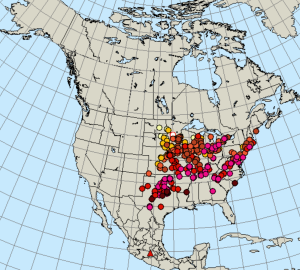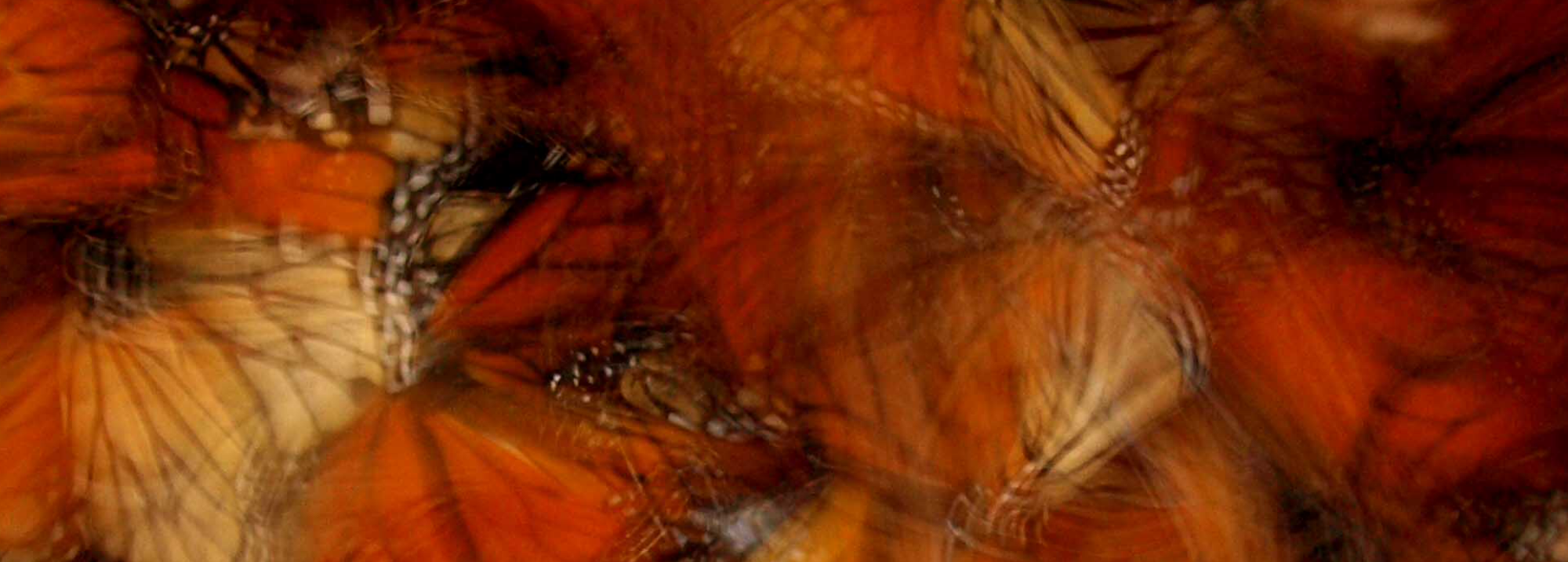Up to four generations have lived since their spring/summer migration to the Northern states and this last “Methuselah generation” of monarchs are flocking together to return to their Mexico sanctuary for 5 months of rest. They are starting to fly into my home state of Texas right now!
This “Methuselah Generation” (the great-great grandchildren) is the name given to the monarchs east of the Rockies because they travel longer distances from Canada and the Northern States to the Oyamel fir trees of Mexico and live longer than previous generations.
(Why this Location? (From Glorious-Butterfly.com)”They choose this thick canopy on the steep, southwest-facing slopes because it provides protection. The climate is close to freezing which puts the Monarchs into a state of torpor(semi-paralysis). Hanging motionless from trees, they expend little energy. The forest streams, clouds and fog provide the moisture the Monarchs need….winter is the dry season. Even with the lipid mass, which stores energy in their bodies, they could die of dehydration on hot days without the moisture found in this micro-climate.”)
The other monarchs in the U.S. either winter over in Florida or the monarchs west of the Rockies migrate to the eucalyptus trees of Pacific Grove in southern California. Beginning in mid-August in the north, adults are in diapause when they emerge from the chrysalis. They are fully grown but not reproductively mature. Their reproductive development is on pause and will not complete development and begin to mate until next spring in Mexico. The same hormone deficiency that lead to diapause also leads to increased longevity. Summer monarchs live only 2-6 weeks; migratory monarch live up to 8 months.

Create Way-Stations
Since they travel 10 times farther (over 2,000 miles) they must not only find food to fuel their migration but also to build sufficient lipid reserves for overwintering. So if you want to do one thing to help them on their journey, then plant fall nectar producing flowers full of the carbohydrates, amino acids and salts that they need (such as Greg’s Blue Mistflower, Texas Frogfruit, Frostweed, Asters, Mexican Sunflower). You will create stop-over sites where they can feed and rest. This also helps promote the health of honey bees and other pollinators as well. No garden space? You can volunteer to help plant Waystations. President Obama threw his hat into the monarch restoration effects in 2015 by earmarking $3.2 million for rescuing pollinators and establishing monarch waystations along the I-35 corridor, which extends from Mexico to Minnesota. It is happening! Mayors are signing the NWF’s Monarch Pledge (24 action items) and San Antonio became the 1st Monarch Butterfly Champion City. Many organizations, conservation groups, schools, Master Gardeners, and Master Naturalist are making this “Monarch Highway” happen. In Texas there is a project underway to help reverse habitat loss called I-35 Rest Area Monarch Waystations where you can volunteer to help.
Update
In the April blog “Plant Milkweed!” we showed our efforts of planting a pollinator garden with the hope that we would get some beautiful blooms and winged visitors. Yes, we have Yellow Sulfur butterfly, Gulf Fritillary, a large convention of Queen butterflies, and hundreds of American Snout butterflies on our False Willow. Fingers crossed that some monarch butterflies will be visiting soon.

Fun Facts:
- Monarchs are one of the few insects capable of making trans-Atlantic crossings.
- They fly at speed ranging 12-30 miles an hour.
- Monarch use “thermals” or updrafts of warm air, just like migrating birds do.
- Male monarch butterflies have a black spot on a vein on each hind wing. females have no spots on this vein.
- The caterpillar poop is called frass.
- Monarch caterpillars only eat milkweed plants.
- Monarch butterflies smell with their antennas and have tiny receptors called tarsi on their feet that they taste with.
Have you ever tracked their fall migration?
You can track migration on real-time maps and you can report your sightings on Journey North website. There is also a free Journey North app for mobile devices. They post weekly updates.

Day of the Dead (Dia de los Muertos)
Monarch butterfly by Euflonica on DeviantArt and Monarch Butterfly Skull by Alfonso Castillo Orta . Five generations of handmade clay sculpture. His daughter Patricia Castillo is continuing this incredible art.
The monarchs’ late October arrival to Mexico is close enough to the Day of the Dead (November 2nd), which is a holiday to commemorate those that have passed on, that two Indigenous tribes, the Mazahua and P’urhepecha in the states of Michoacan and Mexico, have come to associate the return of the monarchs with welcoming back the souls of the ancestors. Here is a video of the “Day of Dead in Mazahua”:
The cover photo

The cover featured image was taken by biologist Jaap de Roode The “De Roode” lab page at Emory University is worth a visit as well as his “Ted” talk on How Butterflies Self Medicate. The parasite “infected female monarchs would choose to lay their eggs on a specific kind of plant that helped the offspring avoid getting sick.”
Learn, Give Thought, Be Inspired, Take Action……Bring Back Balance
Lotus McElfish lotusmcelfish.com
If you would like to subscribe to receive new posts of endangeredandnotsomuch


